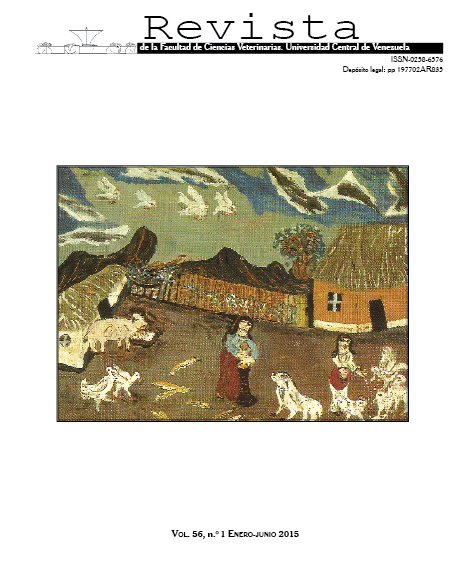Mortalidad en Vacunos entre el Nacimiento y Doce Meses de Edad en Dos Fincas Doble Propósito del estado Trujillo
Contenido principal del artículo
Resumen
Para evaluar el efecto de los factores no genéticos y de grupo racial sobre la mortalidad entre 0 y 12 m de edad, se analizaron 18755 nacimientos, de dos fincas doble propósito, a través de un modelo lineal generalizado utilizando Proc Genmod (SAS),
que incluyó: finca (F: 1, 2), año de nacimiento (An: 1997,…,2010), mes de nacimiento (Mn: enero,…,diciembre), sexo (Sx: macho, hembra), número de partos de la madre (Np: 1,...,9 o más), grupo racial del becerro (Gr: 50EU50CB,
50HO50CB, 50PS50CB, >CEBUE, >EIND, ML) y peso al nacer kg (Pn; ≤ 26,4; 26,5 a 33,4; ≥33,5 kg). La mortalidad fue 8,93%. El factor F fue el único que no afectó la mortalidad (P>0,13).
La mayor diferencia entre An fue 318,27%, con mayor mortalidad en el año 2006 con respecto a 1998. La diferencia absoluta entre el mejor mes (marzo) y el peor mes (octubre) fue 48,96%. Las hembras murieron menos que los machos (14,13%). La mortalidad en hijos de vacas de un parto fue 10,05%, luego decrece para los hijos de vacas de 2 a 5 partos (7,91% en promedio) y un aumento en la mortalidad para los hijos de vacas de 6 a 9 partos o más (8,89%). Becerros con Pn ≤ 26,4 kg tuvieron mayor mortalidad que aquellos con Pn entre 26,5 y 33,4 kg y los que tuvieron Pn ≥33,5 kg, con 10,58; 8,89 y 6,61%, respectivamente. Sin embargo, el comportamiento de Pn puede variar dependiendo del An, debido a la presencia de la interacción de An × Pn. Los Gr con menor mortalidad fueron 50HO50CB y 50PS50CB, con 8,31 y 7,69%, respectivamente. Los factores no ambientales así como Gr tienen un impacto importante sobre la mortalidad en becerros entre el nacimiento y los 12 meses de edad.
Abstract
The effect of non-genetic factors and breed group on mortality between 0 and 12 months of age was evaluated in dual purpose cattle. A total of 18755 calving, from two farms in the State
of Trujillo, Venezuela, were studied. Data were analyzed by a generalized nonlinear model using the GENMOD (SAS) procedure that included: Farm (F: 1, 2), year of birth (Yb: 1997, ..., 2010),
month of birth (Mb: January, ...,December), sex (Sx: male, female), calving number of the cow (Cn: 1,...,9 or more), breed group of the calf (Bg: 50EU50CB, 50HO50CB, 50PS50CB, >CEBUE, >EIND, ML), and birth weight in kg (Bw: ≤ 26,4; 26,5 to 33,4; ≥33,5 kg). Mortality was 8.93%. The F was the only factor that did not affect mortality (P> 0.13). The greatest difference
between Yb was 318.27% more deaths in 2006 than in 1998. The absolute difference in mortality between the best month (March) and the worst month (October) was 48.96%. Female died less than male, with a difference of 14.13%. Mortality in first calving cows was 10.05%, which decreased for 2 to 5 calving cows (7.91% on average) with an increased mortality of 6 to 9 or more calving cows (8.89%). Calves with Bw ≤26.4 kg had a higher mortality than those with Bw between 26.5 and 33.4 kg and those who had >33.5 kg Bw, with 10.58, 8.89, and 6.61%, respectively. However, the Bw behavior may vary depending on the Yb, due to the presence of the YB*Bw interaction. The Bg with lower mortality were 50HO50CB and 50PS50CB, with 8.31 and 7.69%, respectively. It is concluded that non-environmental factors and Bg had a significant impact on mortality of calves between birth and 12 months old.

